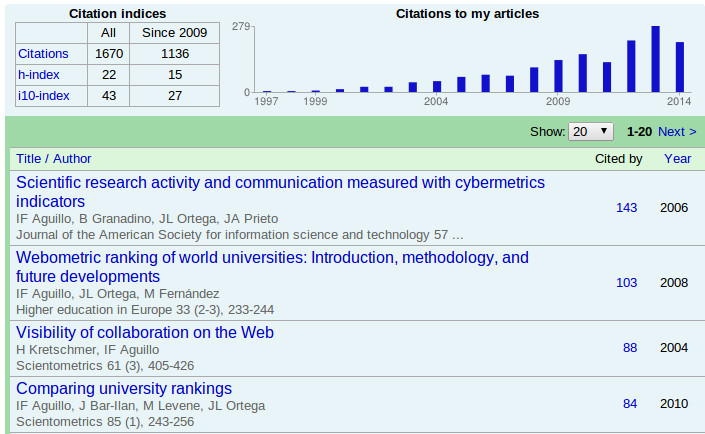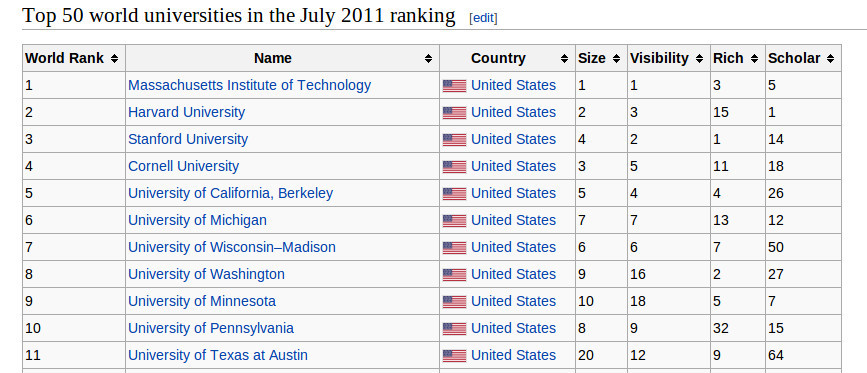Where to go to study: ranking of universities based on reference ranking

We have already talked about the evolution of ranking sites , the causes and history of the emergence of PR, CY, Browserank. Having the initial meaning of improving the quality of the search, this phenomenon eventually acquired commercial value. So the whole branch of the digital industry developed. From our previous post, you know that any ranking has its origins in science. Since the volume of scientific data is also texts and citations, it is not surprising that science has offered such tools to assess its own effectiveness, such as scientometrics, bibliometrics and webometrics. We would like to tell about the latter today, since it ranks scientific and educational institutions according to principles similar to PR. Enjoy reading!
')
Webometrics concept
To avoid confusion, we will immediately indicate differences in terms. It is necessary to distinguish, for example, informatics and infometrics (you can learn more by following the links at the end of the post), as well as the actual topic of our today's text, the webometric itself:
Webometrics (eng. Webometrics) as a section of computer science devoted to the study of the quantitative aspects of the design and use of information resources, structures and technologies in relation to the World Wide Web.
Webometrics ( Webometrix.info ) is a project site dedicated to the ranking of scientific and educational institutions.
Webometrics as a project
The project is implemented by the Cybermetrics Lab research group formed by the Spanish National Research Institute, the largest in Spain and the third largest in Europe.
The head of the group is Isidro Agiyo - if you look at his profile on Google Academy you can see a citation index and other scientific indices for a given academic figure on a living example:

The main areas of work of the research group are the analysis of academic activity on world and regional Internet resources, the assessment of the digital curtain scale between the North American and European high-level universities, and the development of accounting methods for archival documents published online.
Since 2004, the project publishes an annual ranking of universities in the world based on a set of factors, which are calculated on very similar to PR models and other ranking mechanisms in the network. Basic data for analysis are taken from the data present on the educational institution in the worldwide network.

Other ratings
The project also keeps track of the status for other institutions:
- Research institutes - since 2006
- Hospitals - since 2008
- Archival institutions - since 2008
- Business schools - since 2008 (currently suspended due to non-transparency of the presence of information about business schools in the network)
This is not the only index, there are others, such as the magazines US News & World Report (USA) and The Times Higher Education , QS (United Kingdom), the Shanghai rating - but they are tied either directly to the English language, or only to the elite segment of education while Webometrics analyzes about 20 thousand universities around the world.
Methodology Webometrics
The rating takes into account four parameters, each of which has its own weight. The first is the popularity of the site (the number of links to it from the outside), this is the most important parameter, its weight in the overall assessment is 50 percent. The three remaining indicators with a total weight of 50 percent (one third each) characterize the size of the site (number of pages), openness (number of files) and academic quality (publications counted using a special tool).
The number of links to a site matters and is measured using Majestic-SEO, a simple link analyzer that collects them mainly from Yahoo and Google.
The index of the number of publications, according to the methodology of Webometrics, is made up of data from two Internet tools: Scimago SIR, which collects publications in scientific journals, and Google Scholar (Russian version - Google Academy). Of course, due to the fact that Scimago SIR is focused on the English-language bibliography, this indicator will be “failed” for many universities, and besides it will vary greatly for, for example, computer sciences and applied linguistics - the share of publications in English in the first case can reach up to 80-90%, while in the second case it can be very insignificant, since the bulk of publications may fall into other languages.
Will SEO services appear for the scientific community?
The above mentioned lack of a text evaluation method is not the only drawback of a system that is subject to constant criticism also because it can directly influence the success of the indicators of scientists who would like to make a career and have to find a balance between their own scientific activities and the need to calculate their steps and actions. online.
Who knows if this will lead to the creation of "scientific" SEO in the future? Of course not. First, university assessment tools are either used for more convenient data collection and processing, or for an approximate risk assessment when considering educational opportunities abroad.
In the first case, initially the ratings based on the citation index were generally assigned so that the library could easily find interesting literature on the topic. In the second case, the same QS rating is compiled by a company providing training services abroad, and therefore is directed not at the scientific community as such, but at education as an industry.
The special significance of webometrics is still being given primarily to universities in developing countries in search of justifications for their participation in the global scientific community - as one of the few available assessment tools for such a university by representatives of this very global community.
And, finally, in foreign universities, as well as in foreign Internet, “cheating” carries the risk of reputational risks that will not pay off with any external success in the long run of a scientific career, which means that any tools of “cheating” rating in the scientific community were avoided will be avoided in the future.
More on this and related topics:
Infometry
Scientometrics
Wikipedia about webometrics
Methodology of the Webometrics project regarding the assessment of universities
Other indexes:
Science Citation Index
Hirsch Index , citation coefficient, h-index
g-index bibliometric index
i-index , index of publication activity of a scientific organization
IF, Impact factor, indicator of the importance of a scientific journal
RSCI , Russian Science Citation Index
Source: https://habr.com/ru/post/232439/
All Articles